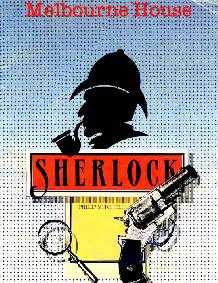Sherlock (video game)
| Sherlock | |
|---|---|
 Cover of the game | |
| Developer(s) | Beam Software |
| Publisher(s) | Melbourne House |
| Platform(s) | ZX Spectrum, Commodore 64 |
| Release date(s) | 1984 |
Sherlock is a 1984 text adventure developed under the lead of Philip Mitchell by Beam Software. It was published by Melbourne House. Five programmers worked for 18 months on the title and a Sherlock Holmes expert was employed full-time for a year to advise the team on accuracy.[1]
Technically, the adventure builds upon the 1982 title The Hobbit. Autonomous NPCs and realtime gameplay, two sophisticated features of The Hobbit, are present in Sherlock - as is Inglish, the parser responsible for analyzing the player's commands. The game simulated 'real time'; trains ran to a time table and key plot events began at exactly specified moments. There was also an attempt to move beyond 'instructional' communication with characters (in which non-player characters are told or asked to complete actions the player does not wish to or is unable to complete) to 'dialogic' communication in which characters could be questioned, challenged and persuaded with evidence. The latter was an early attempt to simulate changing states of consciousness within an interactive narrative.
Plot
A double murder has been committed in the town of Leatherhead and Dr. Watson has encouraged the player, who plays Holmes, to investigate. Inspector Lestrade is also investigating.
Bug
Due to a bug in the game the player can visit the location, called "the" after the location description "You are in the", used for objects that are not created or have been destroyed. The way to get to the is to sit in the cab and tell the cabbie to move away. The game interprets this as you are going away from the cab without paying and the cabbie will get upset and go away (to "the") taking the cab with him (with you inside).
References
- ↑ Mike Gerrard: Adventuring into an Unknown World. In: The Guardian, 1984-08-30, section Micro Guardian/Futures, page 13.
External links
- Sherlock at World of Spectrum
- Images of Sherlock package, manual and screen shots
- Matthew Wilson's page on the game
- Emulator which shows what's going on 'behind the scene' in the ZX Spectrum version
| ||||||||||||||